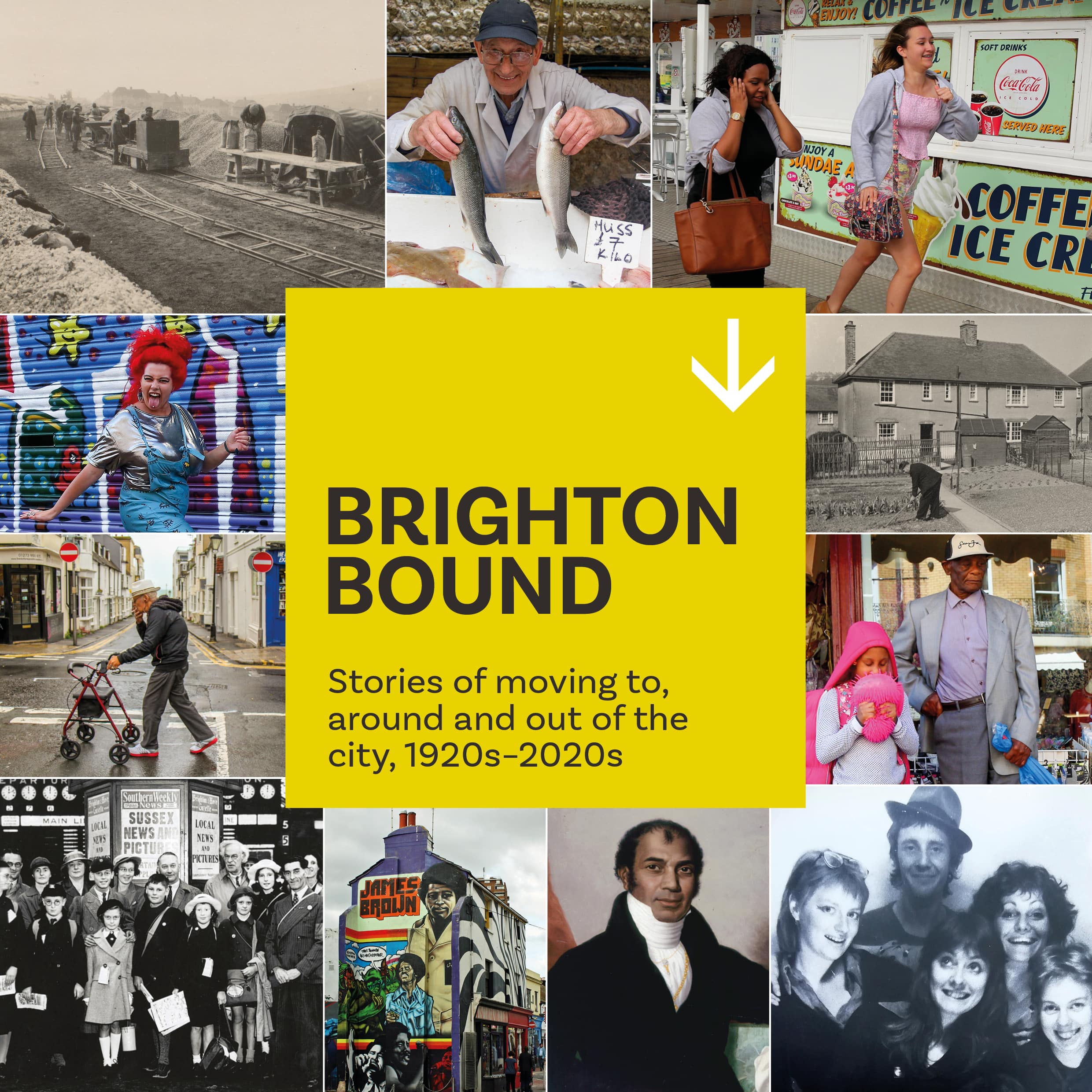‘I moved to Brighton because of lots of the reasons that people move to Brighton, it’s got a lot going on, it’s very gay friendly, it’s by the sea.’ Rachel, in Brighton Bound
Brighton has a long history of inward migration from elsewhere in the UK and from other countries. There has been mass movement within the city too. And, in recent decades, the high cost of housing has pushed large numbers of people out of Brighton…
Fleeing persecution
From the 16th century, some people came to Brighton to escape religious persecution in Europe. The town was known as a place of refuge for non-conformist Christians; Huguenot refugees arrived from Flanders (in present-day Belgium) in the 16th century. Other Nonconformist Churches were also established in Brighton over the following three centuries. Jewish communities developed too – the first recorded arrival was Israel Samuel in 1766, probably from London.
The impact of colonialism
People of colour have lived in Brighton for hundreds of years, owing to Britain’s deep involvement in the transatlantic slave trade and colonisation of other lands. In the 18th and 19th centuries, one by-product of Britain’s role in the slave trade was the demand for young, enslaved Africans in wealthy English households. The children were mostly severed from their homeland merely to provide entertainment. A Yoruba princess, Omoba Aina (1843–1880) was seized in a slave hunt in West Africa. Her captor, Captain Frederick Forbes, renamed her Sarah Forbes Bonetta and transported her across continents as a gift for Queen Victoria. Sarah was forced into an arranged marriage with a Yoruba businessman: they had a lavish wedding in St Nicholas Church, Brighton in 1862 and lived in Brighton for a while.
A few South Asians settled in Brighton in the late 18th century. Probably the most famous is the entrepreneur Sake Deen Mahomed (1749–1851), who developed a therapeutic vapour bath. Born in India, he moved to Ireland, where he married. He and his family moved to Brighton in 1812, and in 1820, he opened Mahomed’s Baths on King’s Road where the Queen’s Hotel now stands. Bathers sat in a steaming bath, infused with Indian herbs and oils, and then received a massage. Mahomed’s treatments became so sought after that he was appointed Shampooing Surgeon to George IV in 1822 and later to William IV.
QueenSpark Books’ 2024 title, Brighton Bound: Stories of moving to, around and out of the city, 1920s–2020s, features stories of some of the individuals and communities that have made Brighton their home over the past 100 years.
It starts with the mass movement of mostly urban working-class people in the 1920s and 1930s from the insalubrious central Brighton slums to the newly built council estates. Sheila Winter described her family’s new home in Moulsecoomb:
The houses were fairly large, with three bedrooms, a scullery and a kitchen, plus a ‘Holy of Holies’, which was the front room, in which all the best furniture was kept. We kids were not allowed into it except on very special occasions… We even had a bathroom with a separate toilet… [And] plenty of garden to play in.
An attractive destination
As a coastal city with a mild climate, the city has drawn migrants from outside Brighton too. Many have come for jobs or have set up restaurants, cafés and other small businesses, while the city’s universities have brought in students and staff. Brighton has become a magnet for its creative culture and for providing a relatively safe space for LGBTQIA+ people. And large numbers have moved ‘down from London’. Some refugees have sought sanctuary in Brighton, while others were dispersed here. From December 2015, Brighton Council accepted a few families fleeing civil war in Syria. Farah was relieved to arrive:
I was born in Damascus… So I’m really upset about what’s happening in my country but I am glad to find [a] safe city to live with my children and my husband.
Welcome…
Brighton has long been seen as a welcoming city, and this reputation is often well-deserved. Gay-friendly pubs developed in Brighton from the 1930s. In the 1950s and 1960s – before the legalisation of male homosexuality in 1967 – many lesbian and gay people moved to the city for a freer new life. For Pat, Brighton was a revelation:
When I came to Brighton I discovered that there were real bars only for men who liked other men. And that there were a lot of these kind of men here. And so I suddenly found myself like a pig in clover. I was here in paradise.
The settlement of newcomers has helped to create a Brighton and Hove multiculture. Thousands line the streets to watch the colourful Pride Parade every August, ice-cream parlours provide a welcome space for non-alcohol drinkers, and there is a greater ease with difference.
And not so welcome…
Yet Brighton is a place of persisting inequalities and injustices too. People of colour continue to experience racism, from microaggressions through to physical attacks. Moving to central Brighton from the Midlands in the early 2020s, Claude, a tall young black man who walks around with headphones and a friendly demeanour, quickly noticed how neighbours would cross the road when he approached or hurry past, avoiding eye contact.
Darius from Iran experienced a random racist attack on the street in the 2010s:
I saw two different people, who talk to me as racist people and punch me and I just stare and look like that. And one English guy come and support me and told that guy: ‘Why you punch him and talk to him like that? He’s human, you are racist.’
A haven from hostility
Many community organisations – including The Bevy and Migrant English Project, which feature in Brighton Bound – do their best to counter such hostility and racism. Luqman Onikosi, originally from Nigeria, helped to establish the Jollof Café at the Westhill Community Centre near Seven Dials. Every Wednesday lunchtime, refugee volunteers cook a hearty, nutritious vegetarian meal for other refugees and friends on a ‘pay as you feel’ basis. It’s a space to relax, socialise and find some support.
Priced out
Unfortunately, the housing crisis has made Brighton too expensive for many would-be residents. Privately rented housing is shockingly costly, yet frequently cramped, damp and poorly maintained. Meanwhile, newly built homes in corporate housing developments are unaffordable for most people. Structural wealth inequalities and institutional racism make it especially difficult for international migrants and people of colour to find somewhere decent to live.
People have been pushed out of the city, often to nearby coastal towns like Shoreham, Worthing and Eastbourne. As Zoë explains:
Well, I grew up in Patcham. I used to live on Ladies Mile Road. I moved to Eastbourne to buy a house because I just had no chance to buy a home in Brighton. I think it’s about your stage in life… at that point it wasn’t giving us what we wanted – really high rent, you know, you’ve got your kids and everything. It’s hard to move forward.
The head of Varndean School, Shelley Baker, spoke to journalist Hannah Fearn about families who had to move away from Brighton in 2023:
Whereas families would previously move to the suburbs of the city when they had children, now they are looking in Worthing or elsewhere in mid-Sussex. Some are even moving to the Midlands or north of England despite having no local connections, just to find cheaper homes.
With many families leaving, some Brighton schools are being hollowed out, with tumbling pupil numbers leading to fewer classes and even school closures.
So while Brighton remains a magnet for migrants, many residents of the city are moving elsewhere.
You can read more about the migration history of Brighton and Hove in these QueenSpark Book titles:
Backyard – Back Street Brighton
Snapshots – Childhood Memories of Southampton Street

